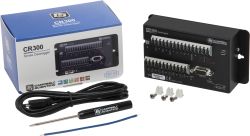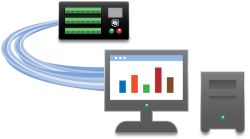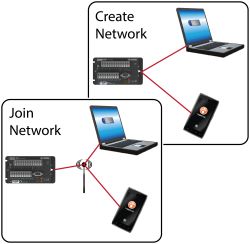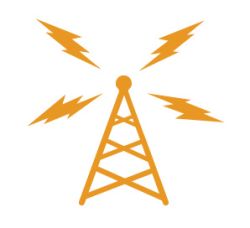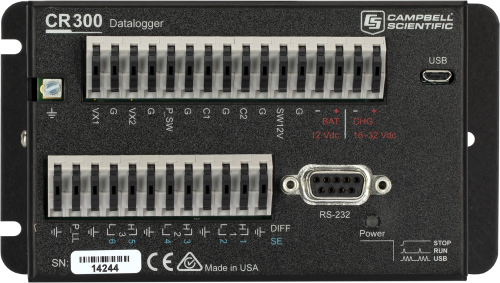






Sehen Sie den QuickStart Guide an.
Überblick
Der CR300 ist ein kleiner Datenlogger mit modernster Technik. Optisch ähnlich dem CR200X enthält er einen besseren AD-Wandler, Differentialkanäle mit excellenter Auflösung, USB-Port, mehr Speicher und die Möglichkeit, 4-20mA direkt zu messen.
Damit können fast alle meteorologischen, hydrologischen und industriellen Sensoren angeschlossen werden. die Daten können dann über verschiedene Netzwerke und Kommunikationsoptionen zugänglich gemacht werden.
Den CR300 gibt es mit verschiedenen Kommunikationsoptionen wie WiFi, Mobilfunk und Funk für unterschiedliche Regionen:
- CR300-RF407: USA und Kanada
- CR300-RF412: Australien und Neuseeland
- CR300-RF422: Europa
- CR300-RF427: Brasilien
Bitte beachten Sie: Campbell Scientific empfiehlt den CR300 nicht als PakBus Router in Netzwerken mit mehr als 50 Geräten. Bei großen Feldern oder String Variablen kann der Speicher nicht ausreichen. Für solche Fälle ist der CR1000X besser geeignet.
Lesen Sie mehrFunktionen und Vorteile
- Kann direkt am USB-Anschluss des Computers angeschlossen werden
- Besonders gute Auflösung der analogen Messwerte (24 bit AD Wandler)
- Einfacher Anschluss digitaler Sensoren wie SDI-12 und/oder RS-232
- Unterstützt den Aufbau von PakBus-Netzwerken
- Webpage auf dem Logger zur Verbindung über Webbrowser
Bilder













Technische Beschreibung
The CR300 is a low-powered data logger designed to measure sensors, analyze data, and store data and programs. A battery-backed clock assures accurate timekeeping. The on-board, BASIC-like programming language—common to all Campbell Scientific data loggers—supports data processing and analysis routines.
The CR300 wiring panel includes a switchable 12 V terminal, and analog grounds dispersed among six analog terminals.
Spezifikationen
| -NOTE- | Additional specifications are listed in the CR300-Series Specifications Sheet. |
| Operating Temperature Range |
|
| Maximum Scan Rate | 10 Hz |
| Case Material | Powder-coated aluminum |
| Analog Inputs | 6 single-ended or 3 differential (individually configured) |
| Pulse Counters | 8 (P_SW, P_LL, C1, C2, and SE1 to SE4) |
| Voltage Excitation Terminals | 2 (VX1, VX2) |
| Communications Ports |
|
| Switched 12 Volt | 1 terminal |
| Digital I/O | 7 terminals (C1, C2, P_SW, and SE1 to SE4) configurable for digital input and output. Includes status high/low, pulse width modulation, external interrupt, and communication functions. Exception: The SE4 terminal doesn't do external interrupt. |
| Input Limits | -100 to +2500 mV |
| Analog Voltage Accuracy |
|
| ADC | 24-bit |
| Power Requirements | 16 to 32 Vdc for charger input (CHG) (Current limited to 0.9 A maximum for power converter or solar panel input.) |
| Power Requirements | 10 to 18 Vdc for external batteries (BAT) |
| Real-Time Clock Accuracy | ±1 min. per month |
| Internet Protocols | Ethernet, PPP, RNDIS, ICMP/Ping, Auto-IP(APIPA), IPv4, IPv6, UDP, TCP, TLS (v1.2), DNS, DHCP, SLAAC, NTP, Telnet, HTTP(S), FTP(S), SMTP/TLS, POP3/TLS |
| Communication Protocols | PakBus, Modbus, DNP3, SDI-12, TCP, UDP, and others |
| CPU Drive/Programs | 80 MB serial flash |
| Data Storage | 30 MB serial flash |
| Idle Current Drain, Average | 1.5 mA (@ 12 Vdc) |
| Active Current Drain, Average |
|
| Dimensions |
13.97 x 7.62 x 4.56 cm (5.5 x 3.0 x 1.8 in.) Additional clearance required for cables and leads. |
| Weight | 242 to 250 g (0.53 to 0.55 lb) depending on communication option selected |
CR300-RF407 Option |
|
| Radio Type | Frequency Hopping Spread Spectrum (FHSS) |
| Output Power | 5 to 250 mW (user-selectable) |
| Frequency | 902 to 928 MHz (US, Canada) |
| RF Data Rate | 200 kbps |
| Receive Sensitivity | -101 dBm |
| Antenna Connector | RPSMA (External antenna required; see www.campbellsci.com/order/rf407 for Campbell Scientific antennas.) |
| Idle Current Drain, Average | 12 mA (@ 12 Vdc) |
| Active Current Drain, Average | < 80 mA (@ 12 Vdc) |
CR300-RF412 Option |
|
| Radio Type | Frequency Hopping Spread Spectrum (FHSS) |
| Output Power | 5 to 250 mW (user-selectable) |
| Frequency | 915 to 928 MHz (Australia, New Zealand) |
| RF Data Rate | 200 kbps |
| Receive Sensitivity | -101 dBm |
| Antenna Connector | RPSMA (External antenna required; see www.campbellsci.com/order/rf412 for Campbell Scientific antennas.) |
| Idle Current Drain, Average | 12 mA (@ 12 Vdc) |
| Active Current Drain, Average | < 80 mA (@ 12 Vdc) |
CR300-RF422 Option |
|
| Radio Type | 868 MHz SRD 860 with Listen Before Talk (LBT) and Automatic Frequency Agility (AFA) |
| Output Power | 2 to 25 mW (user-selectable) |
| Frequency | 863 to 870 MHz (European Union) |
| RF Data Rate | 10 kbps |
| Receive Sensitivity | -106 dBm |
| Antenna Connector | RPSMA (External antenna required; see www.campbellsci.com/order/rf422 for Campbell Scientific antennas.) |
| Idle Current Drain, Average | 9.5 mA |
| Active Current Drain, Average | 20 mA |
CR300-RF427 Option |
|
| Radio Type | Frequency Hopping Spread Spectrum (FHSS) |
| Output Power | 5 to 250 mW (user-selectable) |
| Frequency | 902 to 907.5 MHz/915 to 928 MHz (Brazil) |
| RF Data Rate | 200 kbps |
| Receive Sensitivity | –101 dBm |
| Antenna Connector | RPSMA (External antenna required.) |
| Idle Current Drain, Average | 12 mA (@ 12 Vdc) |
| Active Current Drain, Average | < 80 mA (@ 12 Vdc) |
CR300-WIFI Option |
|
| Operational Modes | Client or Access Point |
| Operating Frequency | 2.4 GHz, 20 MHz bandwidth |
| Antenna Connector | Reverse Polarity SMA (RPSMA) |
| Antenna | pn 16005 unity gain (0 dBd), 1/2 wave whip, omnidirectional with articulating knuckle joint for vertical or horizontal orientation |
| Transmit Power | 7 to 18 dBm (5 to 63 mW) |
CR300-CELL205 Option |
|
| -NOTE- | The CR300-CELL205 option is not compatible with a Verizon cellular network. |
| Certifications | IC (Industry Canada) 10224A-201611EC21A |
| Cell Technologies |
|
| 3G Frequency Bands | 850, 1700/2100 (AWS), and 1900 |
| 4G Frequency Bands | 700, 850, 1700/2100 (AWS-1), 1900 |
| Antenna Connector | SMA (External antenna required; see www.campbellsci.com/order/cr300 for Campbell Scientific antennas.) |
| SIM Interface |
3FF (6 position/contacts) Supports SIMs that require 1.8 or 3 V. |
| Radio Output Power |
|
| Radio Sensitivity Range | -99.5 to 110.5 dBm (10 M) |
CR300-CELL210 Option |
|
| -NOTE- | The CR300-CELL210 option is only compatible with a Verizon cellular network. |
| Cell Technologies | 4G (LTE CAT-1) |
| 4G Frequency Bands | 700, 850, 1700, 1900, 2100 |
| Antenna Connector | SMA (External antenna required; see www.campbellsci.com/order/cr300 for Campbell Scientific antennas.) |
| Power Consumption - Low Power Mode | 5 mA |
| Power Consumption - Idle | 35 mA |
| Power Consumption - Active | 70 mA |
| SIM Interface |
3FF (6 position/contacts) Supports SIMs that require 1.8 or 3 V. |
| Radio Output Power | 23 dBm on LTE |
| Radio Sensitivity Range | -99.5 to 110.5 dBm (10 M) |
CR300-CELL215 Option |
|
| -NOTE- | The CR300-CELL215 option is intended for use in EMEA countries. |
| Cell Technologies |
|
| 2G Frequency Bands | 900 and 1800 MHz |
| 3G Frequency Bands | 850, 900, and 2100 MHz |
| 4G Frequency Bands | 800, 850, 900, 1800, 2100, and 2600 MHz |
| Antenna Connector | SMA (External antenna required; see www.campbellsci.com/order/cr300 for Campbell Scientific antennas.) |
| SIM Interface |
3FF (6 position/contacts) Supports SIMs that require 1.8 or 3 V. |
| Radio Output Power |
|
| Radio Sensitivity Range | -99.5 to 110.5 dBm (10 M) |
CR300-CELL220 Option |
|
| -NOTE- | The CR300-CELL220 option is intended for use in Australia and New Zealand. |
| Cell Technologies |
|
| 3G Frequency Bands |
|
| 4G Frequency Bands |
|
| Antenna Connector | SMA (External antenna required; see www.campbellsci.com/order/cr300 for Campbell Scientific antennas.) |
| SIM Interface |
3FF (6 position/contacts) Supports SIMs that require 1.8 or 3 V. |
| Radio Output Power |
|
| Radio Sensitivity Range | -99.5 to 110.5 dBm (10 M) |
CR300-CELL225 Option |
|
| -NOTE- | The CR300-CELL225 option is intended for use in Japan. |
| Cell Technologies | 4G (LTE CAT-1) |
| 4G Frequency Bands | 800 (lower), 800 (upper), 850+, 900, 1800, and 2100 MHz |
| Antenna Connector | SMA (External antenna required; see www.campbellsci.com/order/cr300 for Campbell Scientific antennas.) |
| SIM Interface |
3FF (6 position/contacts) Supports SIMs that require 1.8 or 3 V. |
| Radio Output Power | 23 dBm on LTE |
| Radio Sensitivity Range | -99.5 to 110.5 dBm (10 M) |
Kompatibel mit
Please note: The following shows notable compatibility information. It is not a comprehensive list of all compatible products.
Software
| Product | Compatible | Note |
|---|---|---|
| LNDB | Version 1.3 or higher | |
| LoggerLink | Version 1.5 or higher | |
| LoggerNet | Version 4.4 or higher | |
| LoggerNet Mobile Connect | Version 1.1 or higher | |
| PC200 (retired) | Version 4.4 or higher | |
| RTDAQ | ||
| Short Cut | Version 3.2 or higher |
Miscellaneous
| Product | Compatible | Note |
|---|---|---|
| PC400 | Version 4.4 or higher |
Additional Compatibility Information
Sensors
With several channel types, the CR300 is compatible with nearly every available sensor. This includes analog output voltage (0 to 2.5 V) and current (0 to 20 mA or 4 to 20 mA) sensors, thermistors, and RTDs to name a few. It is also compatible with pulse or frequency output sensors such as anemometers, rain gauges, and flow meters. CR300 dataloggers are not capable of applying reverse excitation, and they cannot be used with some conductivity or soil matric potential sensors.
SDI-12, Modbus, and other serial sensors are supported with the RS-232 port and C1 and C2 as a Tx/Rx pair. The CR300 does not directly support RS-485 sensors.
Measurement & Control Peripherals
The CR300 is compatible with low current and voltage solid-state relays but not with SDM or CDM devices.
Software
The CR300 series is compatible with CRBasic (version 3.6 or higher).
Enclosures
An ENC10/12 or ENC12/14 enclosure is adequate for most CR300-based systems.
Communications
The CR300 can communicate with a PC directly via its USB port. Compatible telemetry devices include our RS-485 converters, digital cellular gateways, RF telemetry, and satellite transmitters (HDR GOES, Argos, Meteosat, Iridium, and Inmarsat). Data can be viewed on an iOS or Android device (requires our free LoggerLink app), CD295 DataView II Display, or other third-party devices.
| Data Logger Option | Communications Type | Integrated Communications Are Compatible with |
|
CR300-WIFI |
2.4 GHz, 20 MHz bandwidth |
Most other Wi-Fi devices, such as the CR310-WIFI, CR6-WIFI, NL240 |
|
CR300-RF407 |
902 to 928 MHz Frequency Hopping Spread Spectrum |
|
|
CR300-RF412 |
915 to 928 MHz Frequency Hopping Spread Spectrum |
|
|
CR300-RF422 |
868 MHz SRD860 LBT+AFA |
|
|
CR300-CELL |
2G Frequency Bands 850, 900, 1800, 1900 |
GSM/GPRS/EDGE (2G) |
Power
The CR300 uses an external power source and has a built-in charger/regulator. Intelligent power sourcing autoselects the highest voltage from three input sources (CHG, BAT, or USB) to operate in one of the following four modes:
- UPS (recommended) - A 16 to 32 Vdc source, solar panel (SP10, SP20), or power converter (29796) is used to charge a 12 Vdc battery, such as our BP7 or BP12.
- 12 Vdc battery or other reliable 12 Vdc source
- Charge only - DC power supply (16 to 32 Vdc)
- USB - Powered over 5 Vdc USB port for setup, programming, and testing (will not charge battery or boost USB power to provide 12 Vdc to the switched battery terminal SW12)
Dokumente
Broschüren Produkte
Handbücher
Technische Artikel
Übereinstimmung mit Richtlinien u. Vorschriften
Verschiedenes
Videos & Tutorials
Downloads
CR300 Series OS v.11.00 (4.93MB) 21-02-2024
This download is for the CR300 series of dataloggers including all CR300 and CR310 models. Execution of this download places the Operating System file(.obj) on your computer. It also updates the CRBasic Editor compiler and support files.
Why Update? This OS fixes issues related to the TX325/TX326, SDI12Recorder and the addition of MQTT along with other fixes and new features. See the revision history for a complete list. With this OS update, it is recommended that you also update the Device Configuration Utility to the most recent version so that new datalogger features are available in the utility.
Note/Warning: Campbell Scientific always recommends updating operating systems on site if possible. When remote updates are required, it is recommended that you implement the necessary precautions to handle unexpected OS upload complications. All datalogger settings should be retained when updated remotely. If you choose to roll back to a previous operating system, the datalogger settings will be reset to default.
Watch the Video Tutorial: Sending an OS to a Local Datalogger.
CR300 Series Wifi OS Update v.1.7.12 (1.97 MB) 13-05-2022
Manufacturer chipset maintenance update.
CR300 QuickStart Program (569 KB) 15-03-2016
The CRBasic program referenced in the CR300 QuickStart videos and manual.
Data Logger Wiring Excel Template (1 KB) 26-03-2024
This is a data logger wiring diagram spreadsheet template that accompanies the Wiring Diagram Video. The spreadsheet includes templates for CR6, CR1000X, CR300, CR310, and CR350 data loggers. The file is an Excel template and works best with Microsoft Excel.
FAQs für
Number of FAQs related to CR300: 4
Alle anzeigenWenige anzeigen
-
The connector is designed to accept wire sizes from 14 to 28 AWG. Note: If you are using ferruled wire ends, reduce the maximum size to 18 AWG.
-
Verizon recommends using MIMO antennas because their 4G towers have at least two MIMO antennas. If your modem has two MIMO antennas as well, you may benefit from reduced signal reflections, more reliable data reception, and an increase in bandwidth.
While Verizon’s language indicates that MIMO antennas are required because they want to offer the best service possible to their users, technically, a MIMO antenna is not required for any of our products, including the CR300-CELL210 (which does not have a diversity port) and the RV50X and CELL210 (which do have a diversity port to accommodate MIMO antennas). Our users have found that a single antenna works well without noticeable issues.
Anwendungsbeispiele
Overview In 2020, due to the COVID-19 pandemic, the Formula 1 World Championship calendar was subject......lesen Sie mehr




